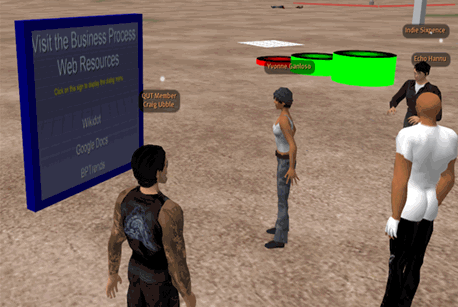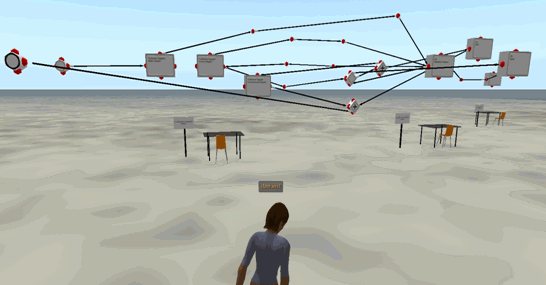Social networking tools dominate communication over the web and this is not limited to sending simple messages between friends but can also include interaction and collaboration within virtual world environments such as Linden’s Second Life application. The targeted use of Web 2.0 social networking applications provides opportunities for communities of practice to collaborate and benefit from shared experience and common knowledge. These tools support geographically dispersed teams through the use of common software applications and data storage areas under the concept of cloud computing. Where distributed teams are commonplace in today’s workplace so is the need to develop supporting forms of communication and technology.
The team and I recently undertook an exercise where we explored the capability of Linden Second Life to support a trivial process modelling exercise. Our scope was to explore how Web 2.0 techniques, social networking tools and virtual world environments can be used to support the collaborative design of business process models. Now while I was excited by the possibility, I was also sceptical about the practicalities – what blockers would there be…
So, into SL we jumped and found a spare patch of ground to run our brief experiment.
Once underway the flexibility and value of this approach quickly became apparent, the medium provided a real time collaborative process modelling environment which is also extendable with other emerging features – I’m impressed!
Modeling in the virtual world allowed for real time synchronous representation of changes and immediate contextual discussions. Challenges encountered included the initial learning of the second life concepts and functionality, and knowledge of the availability and appropriate use of the collaboration tools. By example, we have shown that Second Life provides the platform for collaborative, role based, synchronous activity.
Web 2.0 applications facilitate group participation, contribution and interaction and via the network affect, become more useful as more people join and contribute. These applications such as wiki’s, social bookmarking sites, blogs and RSS feeds allow for the socialization of process modeling tasks and makes the modeling exercise more creative and participative. Through the functionality of these tools, a self governing, networked community of modelers can develop, review and modify process models in a real time collaborative environment.
In essence, process modeling team member individual contributions and opinions create value through combination and collaborative filtering, producing valuable outcomes and decisions that may not be initially apparent at the commencement of the exercise.
Due to their ease of use and the rapid deployment cycle of Web 2.0 applications, there is an added advantage of a minimal learning curve to adopt these ‘transparent technologies’ allowing the Modelers to focus on the task at hand not the supporting tools. Most Web 2.0 tools are built on the basis of meeting a direct user requirement so tend to be intuitive and integrate well with other existing web applications.
Through the adoption of Andrew McAfee’s SLATES paradigm, Web 2.0 applications can be assessed for their appropriateness for use in a collaboration context. Using McAfee’s table as a guide, we can assess this functionality against Lindens’ Second Life application.
Search
Second Life does offer the ability to search for both people and locations (maps). In the context of our process modelling exercise, this allowed the project team to find other members and also create a site to conduct the exercise. In addition, other Second Life users with appropriate access rights can also discover the process models and may choose to offer input. This ability to locate and share knowledge and expertise is one of the key benefits to using a virtual world platform.
Links
The sharing of links or URL’s to other Second Life locations can be easily accomplished either “in world†or via supporting technologies such as wiki’s or blogs. In the context of this modelling exercise, any knowledge or process models created can then be easily shared with other sites and Second Life users.
Authorship
The level of Authorship allowed in Second Life is high due to the generally open access model in place. Each participant is able to function “in world†independently of others in the modeling team and contribute their knowledge, experience and insight to the project. By way of example, to support our process modeling exercise we established a team wiki site, used to collate and organize reference material and an overall project plan.
Tags
Second Life does not offer a tagging function which categorizes potential search variables and terms. Some sites such as Flickr for sharing photographs or the delicious social bookmarking site use tagging to group large amounts of similar data to improve the quality of search returns. Tagging would provide visibility to data searching trends and patterns within Second Life.

Extensions
Further to Tagging is the concept of Extensions whereby similar information is offered to the User “if you are looking at that, then by extension you will want to look at thisâ€. Second Life does not offer this level of functionality.
Signals
This final element relates to the ability to feed or signal when new content is added on sites of interest. An example of this would be RSS or “Really Simple Syndicationâ€. Having an embedded RSS feed within Second Life would allow project team members to be alerted when new information was added or changes made to the collaboration project.
An initial period of learning the basic functionality was followed by exploration and research into the environment and it’s practical use by other corporations. Interestingly, we discovered that the world’s largest corporations such as IBM and Accenture are using Second Life in the same manner as our intended purpose.
The actual “in world†process modeling experience was highly valuable and much more collaborative than I had envisaged. The use of the provided tools supported by the chat function allowed the project team to easily discuss and alter the process model in real time. I believe the added functionality of voice would be a major benefit to this exercise.
Conceptually, the use of a private space for process modeling by a geographically dispersed team is highly possible in Second Life. This approach is a step beyond the traditional video-conference approach as mannerisms and other non verbal signals can also be used to convey intent
- Business Process Modeling in Second Life - November 17, 2009








